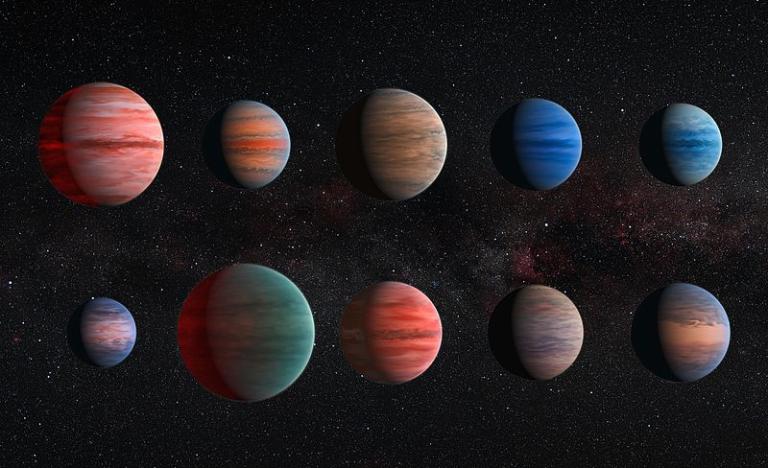
An artist’s impression from the European Space Agency and NASA based upon images from the Hubble Space Telescope (Wikimedia Commons)
Unless I’m seriously mistaken, there were no confirmed planets outside our solar system when I was a kid. We assumed that they were there, but we didn’t know it. Now we do.
(Of course, we can — just barely — see only the very biggest of them, which is why the “exoplanets” shown above are all quite large.)
This image shows an artist’s impression of ten hot “Jupiter-class” exoplanets. From top left to lower left these planets are WASP-12b, WASP-6b, WASP-31b, WASP-39b, HD 189733b, HAT-P-12b, WASP-17b, WASP-19b, HAT-P-1b and HD 209458b. (The letter “b” indicates that the planet is the second known in its solar system.)
The images are to scale with each other. HAT-P-12b, the smallest of them, is approximately the size of Jupiter, while WASP-17b, the largest planet in the sample, is almost twice that size. The planets are also depicted with a variety of different cloud properties.
There is almost no information about the actual colors of the planets available, with the exception of HD 189733b, which became known as the blue planet (heic1312).
The hottest planets within the sample are portrayed with a glowing night side. This effect is strongest on WASP-12b, the hottest exoplanet in the sample, but also visible on WASP-19b and WASP-17b. It is also known that several of the planets exhibit strong “Rayleigh scattering,” an effect that causes the blue hue of the daytime sky and the reddening of the Sun at sunset on Earth. It is also visible as a blue edge on the planets WASP-6b, HD 189733b, HAT-P-12b, and HD 209458b.
The wind patterns shown on these ten planets, which resemble the visible structures on Jupiter, are based on theoretical models.
I see such things as particularly appropriate for a Sunday because I think it’s Sabbath-suitable to contemplate how big the Whole Thing is, and how little we actually know about it. (I offered a brief meditation on one plain indicator of our ignorance here.)











